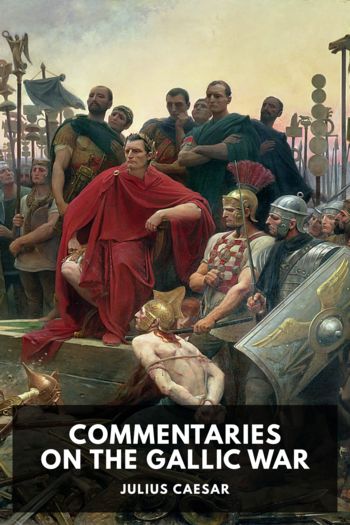Fateful Lightning: A New History of the Civil War & Reconstruction by Allen Guelzo (icecream ebook reader txt) 📗

- Author: Allen Guelzo
Book online «Fateful Lightning: A New History of the Civil War & Reconstruction by Allen Guelzo (icecream ebook reader txt) 📗». Author Allen Guelzo
The Confederacy’s military leadership has generally gotten much higher grades than its political leadership, and more sympathetic biographies along with them. Douglas Southall Freeman, Lee’s Lieutenants: A Study in Command (New York: C. Scribner’s Sons, 1942–1944) offers in three massive volumes a collective biography of the command structure of the Army of Northern Virginia. Close behind Lee as an interesting biographical subject is Thomas Jonathan “Stonewall” Jackson, who was the subject of a biography by his chief of staff, Robert Lewis Dabney, even before the Civil War was over. James I. Robertson’s massive Stonewall Jackson: The Man, the Soldier, the Legend (New York: Macmillan, 1997) can be supplemented by the essays on Jackson’s character and campaigns in Whatever You Resolve to Be: Essays on Stonewall Jackson, ed. A. Wilson Greene (Knoxville: University of Tennessee Press, 2005 [1992]) and Robert Krick’s The Smoothbore Volley That Doomed the Confederacy: The Death of Stonewall Jackson and Other Chapters on the Army of Northern Virginia (Baton Rouge: Louisiana State University Press, 2002). The most frequently studied Confederate officer in the west is Nathan Bedford Forrest, whose colorful and combative career has been described in Brian Wills’s A Battle from the Start: The Life of Nathan Bedford Forrest (New York: HarperCollins, 1992). Braxton Bragg had only a half a biographical life from Grady McWhiney until Judith Lee Hallock’s Braxton Bragg and Confederate Defeat, Volume Two (New York: Columbia University Press, 1991) completed the two-volume biography McWhiney began in 1969.
The war was hardly over before its survivors began speculating on why the South lost the Civil War, and among modern attempts to answer that question, the most far-reaching, and also the most eccentric, is Richard E. Beringer, Herman Hattaway, Archer Jones, and William N. Still, Why the South Lost the Civil War (Athens: University of Georgia Press, 1986). Beringer et alia are followed in interpreting the Confederacy’s defeat as a collapse from within by Paul D. Escott in After Secession: Jefferson Davis and the Failure of Confederate Nationalism (Baton Rouge: Louisiana State University Press, 1978), David J. Eicher in Dixie Betrayed: How the South Really Lost the War (New York: Little, Brown, 2006), and Armstead Robinson in Bitter Fruits of Bondage: The Demise of Slavery and the Collapse of the Confederacy, 1861–1865 (Charlottesville: University of Virginia Press, 2005). But Anne Sarah Rubin in A Shattered Nation: The Rise and Fall of the Confederacy, 1861–1868 (Chapel Hill: University of North Carolina Press, 2005) and Gary Gallagher in The Confederate War: How Popular Will, Nationalism, and Military Strategy Could Not Stave Off Defeat (Cambridge, MA: Harvard University Press, 1997) argue that the Confederacy succumbed to simple Union military might. Jefferson Davis’s last, desperate bid to save the Confederacy by sacrificing the South’s most potent symbol of localism and independence has been chronicled by Robert F. Durden in The Gray and the Black: The Confederate Debate on Emancipation (Baton Rouge: Louisiana State University Press, 1972) and Bruce Levine in Confederate Emancipation: Southern Plans to Free and Arm Slaves During the Civil War (New York: Oxford University Press, 2006).
NINE. WORLD TURNED UPSIDE DOWN
The opening vignette of Willard Glazier’s descent into powerlessness is drawn from Glazier’s own postwar descriptions (which were based on a wartime diary he kept) and on John Algernon Owen’s sensationalized biography of Glazier, Sword and Pen: or, Ventures and Adventures of Willard Glazier (Philadelphia: P. W. Ziegler, 1889). The agitation African Americans raised for civil rights and military enlistment has been ably discussed in George M. Fredrickson, The Black Image in the White Mind: The Debate on Afro-American Character and Destiny, 1817–1914 (New York: Harper and Row, 1965) and James M. McPherson, The Struggle for Equality: Abolitionists and the Negro in the Civil War and Reconstruction (Princeton, NJ: Princeton University Press, 1964). These books are largely concerned with the record of Northern blacks, and Leon Litwack’s Been in the Storm So Long: The Aftermath of Slavery (New York: Knopf, 1979) should be read for the attention it lavishes on the experience of freedom for former slaves. The record of the African American soldier, once he was permitted to volunteer, has been chronicled in Dudley Taylor Cornish’s The Sable Arm: Negro Troops in the Union Army, 1861–1865 (New York: Long-mans, Green, 1956), Joseph Glatthaar’s Forged in Battle: The Civil War Alliance of Black Soldiers and White Officers (New York: Free Press, 1990) and Noah Andre Trudeau’s Like Men of War: Black Troops in the Civil War, 1862–1865 (Boston: Little, Brown, 1998). The Civil War in the western territories has usually been told from the viewpoint of military action, without much consideration to the racial and ethnic significance of these small-scale conflicts in the context of a war that was preoccupied with the question of race. Alvin M. Josephy’s The Civil War in the American West (New York: Knopf, 1991) offers a highly readable survey of the various military actions west of the Mississippi.
Women’s history has become its own separate department within Civil War studies, and we may as well date its emergence to the nearly simultaneous publication





Comments (0)